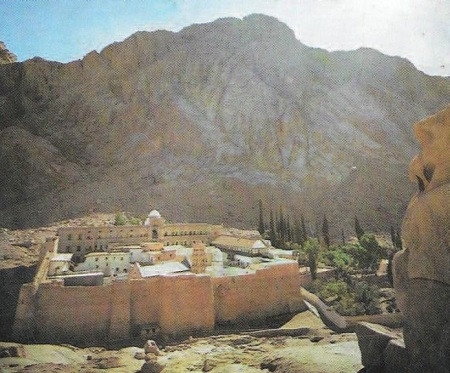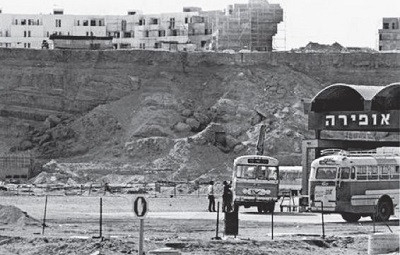A Return Flight to the Past
A message on Facebook on the Israeli Lovers of History site was forwarded to me and there it was - the reproduction of a picture postcard showing an Arkia Airlines Herald aircraft on the runway at Eilat Airport from times that were - about 50 plus years ago – a postcard sent by my parents who were on honeymoon in Eilat."
Memories immediately flooded into my mind: Arkia, Eilat, Dakota, Herald, Viscount, BAC 111 - all aircraft purchased and operated by Arkia from the early 1960s and onwards. Flight and tourist development – my brain signaled me to go to my bookshelves and search for a small book that I knew must be nestling somewhere in there, and indeed it was:
"BLUE SKIES, RED SEA"
The story of the town of Eilat and Arkia, Israel's Inland Airline.
The book was written by Arnold Sherman and is today a remarkable memorial to the development of Eilat and the promotion of tourism, not just in the region of Eilat, but also in the Sinai Peninsula. Turning the pages I was down there all over again, employed by the Arkia Inland Airlines from the early 1960s.
This, too, was a part of my life. blue skies which were not always blue, nevertheless they were dotted with an ever-growing number of Arkia flights - not just within the limited mileage of Israel, but with additional tastes of overseas as well.
The expansion of Israel's borders following the Six Day War paved the way to new routes for Arkia. It established a route to Atarot Airport near Jerusalem, on the way to and from Eilat, and improved the airstrip in Haifa to suit the Herald Aircraft for the operation of direct flights to Eilat. Sde Dov Airport's short runways were unsuitable for the operation of the Viscount Aircraft and so another operation base was opened for Arkia at Lod (later to be named Ben Gurion) airport, and it was from there that the tourism to Sinai took off – in every way.
To generate the development of tourism, new routes to the Sinai tourist sites of Sharm-el-Sheikh and to the Monastery of St. Katherine were established. Of course, that meant the improvement of what was just a landing site for the Israeli Air Force at Sharm-el-Sheikh, which was renamed Ophira by Israel. An airport and suitable runways were constructed there, together with a new Israeli township that began to develop tourist accommodation. As tourism to Mount Sinai and the Monastery was to be developed, Arkia became responsible for the construction of proper airport and runway facilities there as well.
What a challenge – the area of Sinai that remained in Israel's control was extracted from centuries of desert silence which had been disturbed mostly by the life of Bedouin tribes, and in the area of Mount Sinai by the voices of Coptic Christian Monks in prayer. It was in the year 527 AD that the Byzantine Emperor Justinian sent both monks and workers to build the monastery that should enshrine the Burning Bush. This is one of the oldest monasteries in the world and within its walls lies a treasure trove of icons and ancient manuscripts – some of the rarest to be found. Many people with an interest in the monastery will know the story of the Jebeliya tribe, "the Mountain people". They were also sent around 529 CE; they were procured from Rumania by Justinian in order to serve and protect the monks. Gradually they established themselves as a distinct tribe among other South Sinai Bedouin, eventually converting to Islam. Nonetheless, until the eighteenth century some held on to their Christian origins, and Bedouin of Arab descent refused to marry them, describing them scornfully as 'ruumi' (Byzantines).
Then, as of the early 20th century, the rumble of machinery involved in a limited excavation and extraction of oil and ore deposits in a few remote southern areas, but which were later developed; first by Egypt, with the help of the Italian National Oil Company, and later by Israel post 1967.
And so, forward it went – the building and developing of areas for tourism and adventure. Israel was entering a new era, and one to be proud of. Multiple markets were established within Christian and other societies across the world, and for the sea and sun worshippers, including Eilat in Israel, and the ongoing development of many coastal areas of the Red Sea. The planning and operation of the tours to Mount Sinai and St. Katherine's Monastery were special and brought me into contact with interesting groups, of which the Makuyas were one.
They are of Japanese ethnicity and hold a belief that they should "return to the dynamic faith of the original Gospel of early Hebraic Christianity as opposed to the dogmatic, institutionalized, European-dominated churches". They want to return to the Hebrew roots of religion and they learn and teach the Bible according to this belief. Some of their followers studied in Jerusalem and heard of our tours to Mount Sinai and from this, tour programs to Israel and Sinai were developed for many groups who came and felt blessed to be in the Land of Israel.
Sales and marketing were such a challenge then, as doors and gates opened up for Israel; post 1967 much world sympathy lay with our small state, which had stood firm against enemies on all of its borders. There was a further setback in 1973 with the Yom Kippur War, but that, too, was overcome and markets grew and multiplied. Building tourism together with flights, hotel accommodation and tour facilities that were ready and waiting for use was a challenge and we went for it – and therein many a tale can be found and many a new and interesting friendship was formed.











Comments